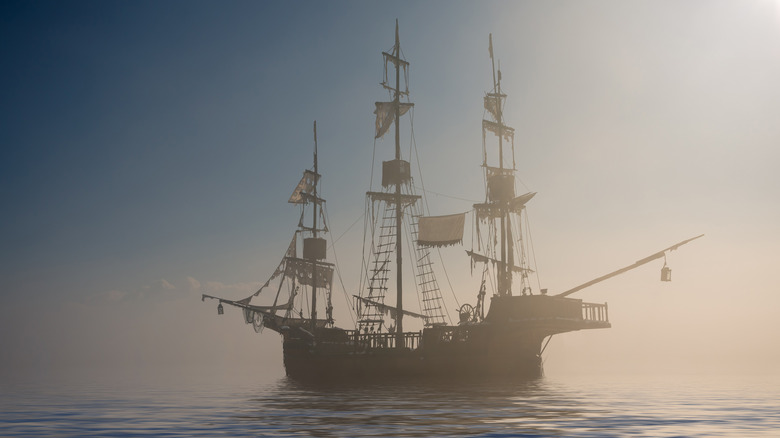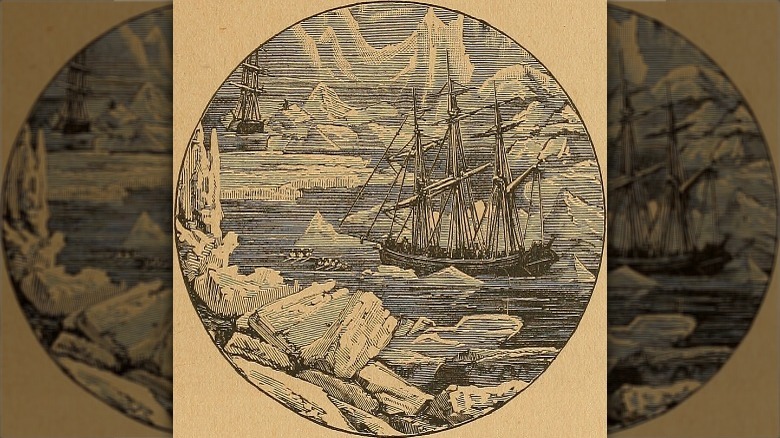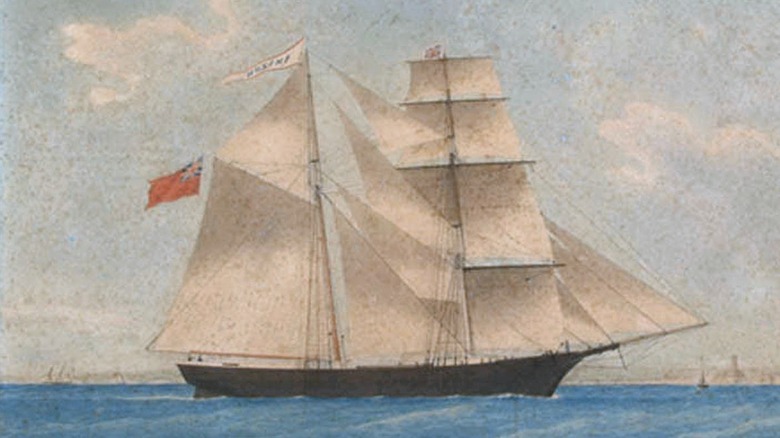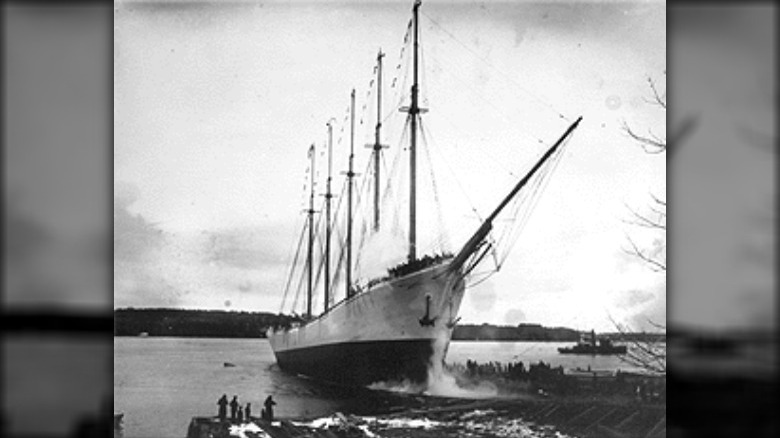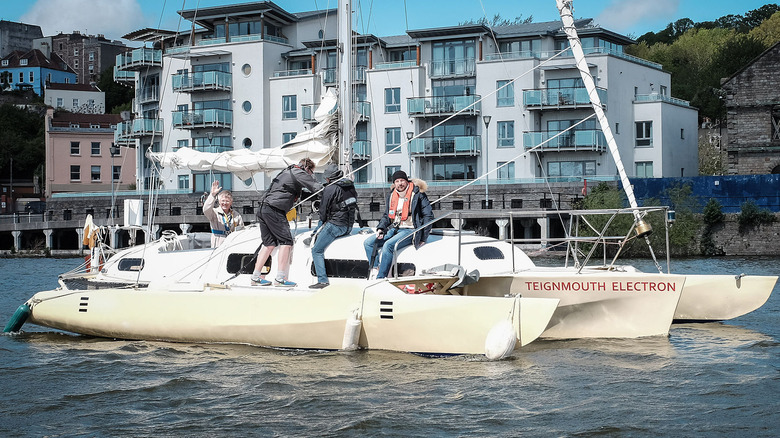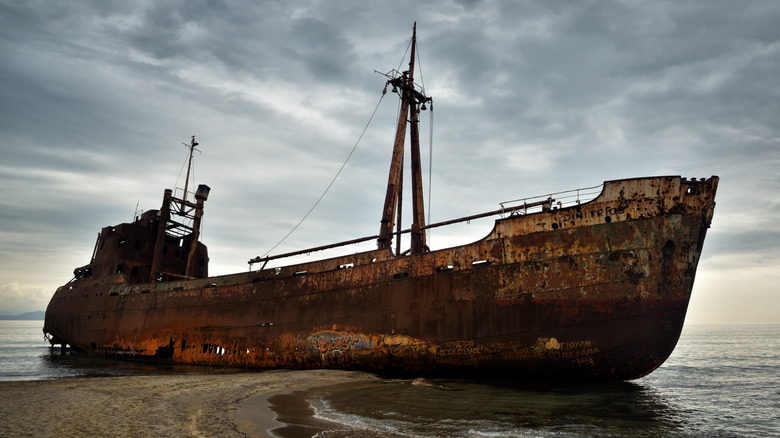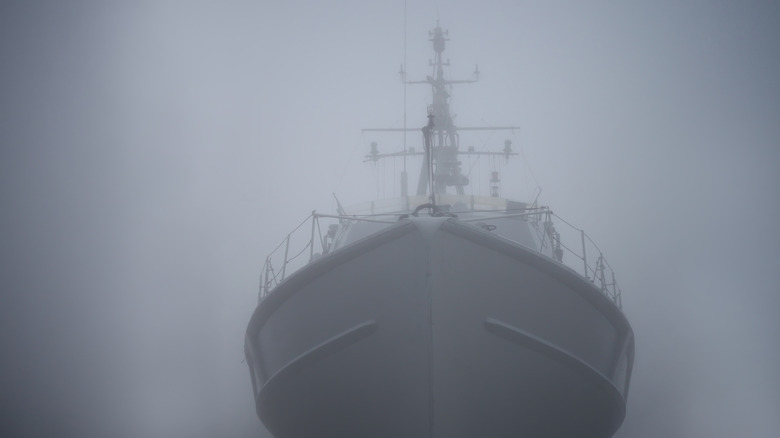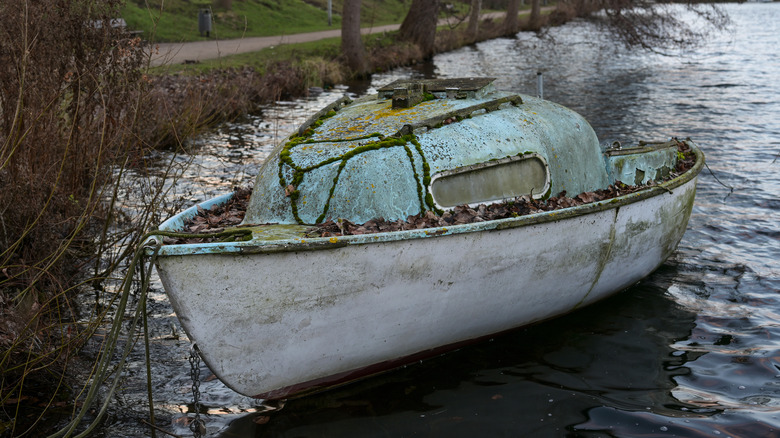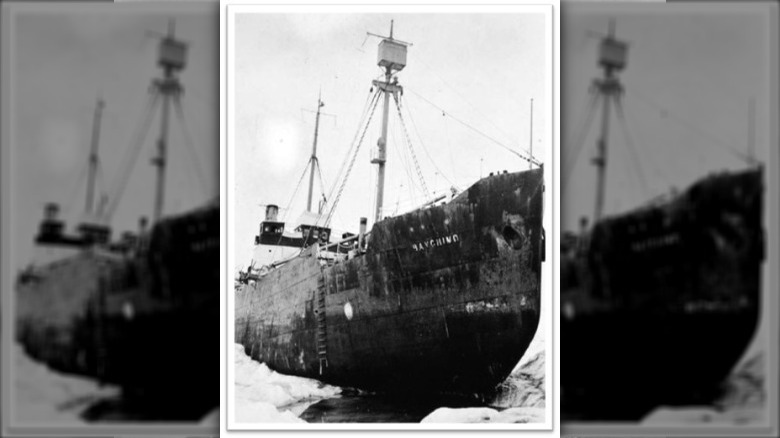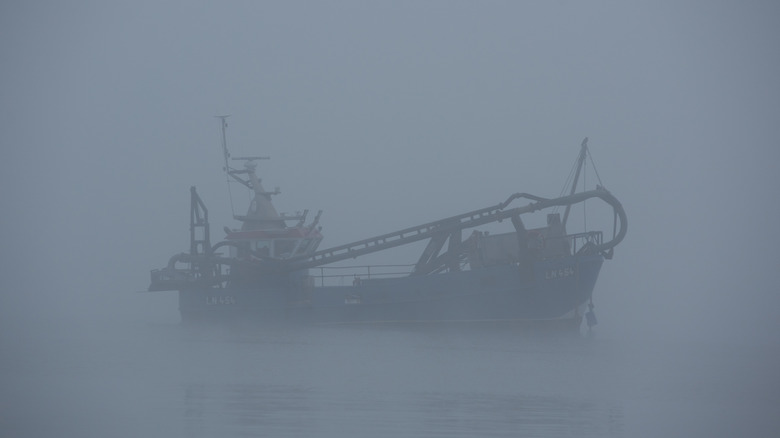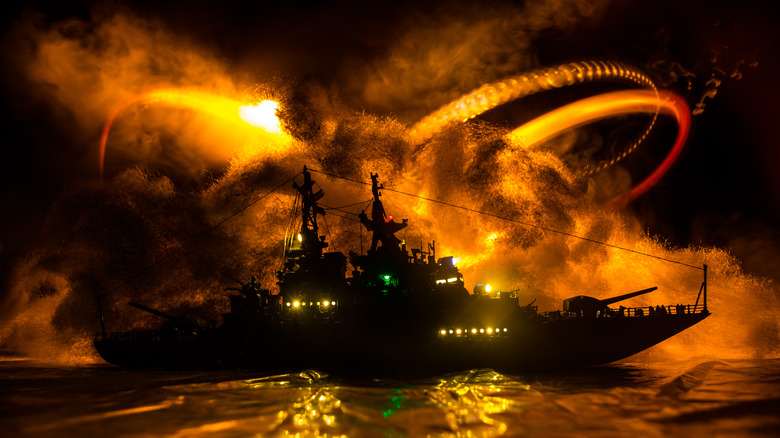Ghost Ships That Mysteriously Sailed The Seven Seas
If you heard the term "ghost ship," what's the first thing that comes to mind? Maybe it's the image of a creepy ship fitted with tattered sails, manned by a crew of the undead, making their way across the sea under the cover of night. Or maybe it's something more specific, like the legend of the Flying Dutchman and its captain, cursed to sail the seven seas until the day he finally finds love. Then again, maybe your thought is something a tad more general: a ship so haunted by the spirits of the dead that it somehow sails the oceans entirely alone, not a single crew member in sight.
Of course there are plenty of supernatural sailing tales, but in reality, ghost ships actually do exist. At least, they kind of exist, but not quite in the way you might be hoping. See, it's not unheard of for ships to just be found in the middle of the ocean, apparently crewed by no one. Sometimes, the crew is found still on board but dead, and other times, the ship is well and truly abandoned, drifting alone across the high seas. In many of these situations, though, there's something dark, strange, or downright confusing in the stories of these apparently haunted ships. And, naturally, there are also those tales that walk the line between truth and fiction. Either way, these are quite the sailing stories.
The Octavius
In 1762, a ship called the Octavius was scheduled to return to England from Asia, setting off amidst favorable weather, per Ancient Origins. Consequently, the captain of the ship decided that it would be worthwhile to take a risk: sail back to Europe through the Northwest Passage, which had never before been completed successfully.
And that's all anyone knew for 13 years. While sailing near Greenland in 1775, a ship called the Herald happened upon the Octavius trapped in the ice. The crew stepped on board, only to be greeted by a terrifying sight: the Octavius' crew dead below deck, perfectly preserved by the ice. They also found the captain still in his chambers, frozen in the midst of writing a note, his wife and child in frozen slumber. All three were kept in an icy, deathly stasis, and the Herald's crew ran. After they read the captain's notes, though, they realized something: Given the last log entry placed the ship near Alaska, the Octavius had actually made the journey through the Northwest Passage. The crew had just been dead that whole time.
And that's led to some questions. While hypothermia isn't unlikely, why did the cold apparently kill the crew in an instant, freezing them in the middle of normal tasks? And, to make things stranger, there aren't any records of the Octavius. There are records of a ship called the Gloriana, though, which was found in bizarrely similar circumstances and in the exact same year.
The Mary Celeste
Maybe the fact that misfortune befell the Mary Celeste shouldn't really be all that surprising. After all, as History says, the ship already had a history of poor luck, including the death of its first captain and an accident on the sea. Nonetheless, it set sail from New York on November 7, 1872, headed for Italy. But it wouldn't make it. It was found on December 5, hundreds of miles east of the Azores and completely devoid of life. No captain, no crew, and a hold still full of food, as the ship was largely undamaged. A lifeboat was missing, though many of the crew's belongings still remained on board (via Smithsonian Magazine), and the crew themselves had disappeared into thin air.
So, what happened? Well, that's a good question, and the answers posited over the years have occasionally tended toward the fantastical –- seriously, some of the theories on this involve the ship being attacked by a literal sea monster. If you're looking for real answers, though, sea monsters probably aren't it. Mutiny was thrown around as a possibility, as was the thought that the alcohol carried on board had exploded. The British vice admiralty at the time even considered the idea that the crew who found the Mary Celeste had lied about simply stumbling upon the ship; perhaps there was foul play involved. Or maybe this was just a case of human error, and the captain had ordered the crew to abandon ship, thinking it was taking on more water than it really was.
The Carroll A. Deering
The Carroll A. Deering had a short –- but undoubtedly exciting -– lifespan. About two years after its maiden journey, the ship was found washed up at Diamond Shoals, North Carolina, "Ghost Ship of Diamond Shoals," by Bland Simpson, in January 1921. To put it lightly, the ship was in pretty rough shape, with its steering wheel and other mechanisms either broken or missing. The lifeboats were gone, as were any written records of what might have happened. And the crew and captain were also gone, although the where and why remain mysteries -– after all, it's a strange story, given that a pan of ribs and a pot of coffee were still sitting on the stove, as if someone was in the middle of cooking when the ship was left abandoned.
So, in the absence of facts, just what are the theories as to what happened? Well, the last sighting of the ship on January 29, 1921, shortly before being found abandoned, the ship hailed land, but those who saw it noted odd behavior from the crew, and they wondered where the captain actually was. There was certainly speculation of mutiny.
Or, of course, there are the slightly wilder theories. Piracy was cited as a possibility, though the specifics ranged from German U-Boat captains looking to restart wars to Bolshevik ships raiding other vessels. Some people even suspected bootlegging to be at the root of the problems.
The Teignmouth Electron
On October 31, 1968, Donald Crowhurst set out to circumnavigate the world. But he didn't make it –- he actually didn't even get close –- and instead, his name was committed to the history books for a completely different reason.
Per The Guardian, the whole story started with a competition: the Sunday Times Golden Globes Race, which tasked a one-man crew to circle the entire globe (and be the first one to do it). Crowhurst decided to take part, but he was more than a little ill prepared for it, almost immediately falling behind his competition. In fact, he never made it out of the Atlantic Ocean, but he found a way to try and salvage valor for himself — by lying. He falsified reports in his logs, claiming record-high speeds and citing locations around the world as he pretended to pass them by. The intention was to simply rejoin the rest of the competition as they reached the finish line, but that never happened. Instead, his ship, the Teignmouth Electron, was found drifting, Crowhurst nowhere in sight.
His family is convinced Crowhurst didn't die by suicide at sea, notes The Guardian. But what is somewhat telling is the log he left behind, filled not only with routine reports but also increasingly rambling and erratic discussions of the human condition. The very last log entry embodies that tone, while also foreshadowing a potentially dark end: "It is finished –- It is finished IT IS THE MERCY."
[Featured image by Gothick via Wikimedia Commons | Cropped and scaled | CC BY-SA 3.0]
The High Aim No. 6
When Australian officials came across the fishing boat called the High Aim No. 6 in January 2003, well, it wasn't exactly clear what had happened. See, according to The New York Times, a Taiwanese fishing boat in Australian waters wasn't surprising, even when official photos showed the deck of the ship empty; since foreign fishing is illegal, the crew hanging out below deck wasn't anything new. But when the boat was found drifting just a few days later, on January 9, then the questions started to flood in.
Investigations found the ship completely empty where the crew was concerned, but it certainly didn't look like they'd been gone long, leaving behind everything they owned. Nearly all of the ship's valuables were accounted for, too, including literal tons of refrigerated tuna. As far as anyone could tell, it seemed like the crew had just up and vanished on January 3, based on the ship's calendar.
Further research revealed that the ship had been all the way over in the Marshall Islands and was reported missing just after, but that didn't really answer the big questions. Mutiny and piracy were both raised as possible explanations, though they don't account for why valuables were left behind, not to mention the apparent lack of violence. And while it's also possible the crew took the life boat and abandoned ship, why would they have done that? And given the weather was fair at the time, why did they never resurface?
The Jenny
In the mid-1800s, a story about a ghost ship began to spread across Germany, and it was quite the harrowing tale. As the legend goes, in September 1840, a ship called the Hope happened upon the silhouette of a ship down in the Drake Passage, near Antarctica (via the journal Polar Record). Upon closer inspection, this ship -– the Jenny –- was trapped in the ice, and as the Hope's crew climbed aboard to investigate, they found that everyone inside had frozen to death. And they found that this wasn't a recent accident; the captain's logs explained that the crew had managed to keep a fire going for just over 70 days before it went out for good ... back in January 1823. For over 17 years, the Jenny's crew had been frozen in time, while the ship itself had been without a single living soul.
Now, that would be quite the tale to tell around the campfire, but that might be all it is. Tracing back the roots of this story is basically an impossible task, and it seems to have just sprung up in the mid-1800s without a lot of evidence to back it up. What's more, the narrative of the Jenny sounds a whole like that of the Octavius, excepting a few small details: a 19th-century Antarctic setting rather than an 18th-century Arctic one, for example. So is the legend of the Jenny one that's migrated through time and culture, changing based on the world at the time? It definitely could be.
The Sayo
When you think about mummies, ancient Egypt has got to be the first thing to come to mind, right? You'd probably be pretty hard pressed to go about life without having that sort of association somewhere. Given that, it's probably hard to imagine mummies having anything to do with boats, but, well, that's the case with the Sayo.
According to The Guardian, on February 25, 2016, a yacht called the Sayo was spotted near the Philippines. On the surface, that's not all too weird, except for the fact that the Sayo hadn't been seen since all the way back in 2009. And that's far from the end of it. Once the ship was boarded, investigators were in for a gruesome sight: the fully mummified body of 59-year-old Fritz Bajorat. Further investigation indicated that the cause of death was likely a heart attack, and that Bajorat had probably been dead for about a week, his body mummifying due to the hot, salty air.
But then, there was an apparent change in that narrative. The Independent reported that Bajorat and his ship had actually been found on January 31 by a yacht crew racing between Australia and Vietnam. They reported the body to the U.S. Coast Guard, then kept quiet after being told to return to their race. After that? There was nothing, and it sounds like the Sayo was allowed to float across the ocean for nearly another month.
The SS Baychimo
In many famous stories about ghost ships, the ships themselves aren't usually sailing unmanned for all that long. It's not often that the ship is able to manage that for over a year, and it's even rarer still that it's alone for multiple years on end. But then there's the SS Baychimo.
As Discovery explains, the ship had quite the storied history before joining the Hudson's Bay Company, at which point it would make trips throughout the Arctic, typically skirting around Canada. But in October 1931, the SS Baychimo ended up completely trapped in the ice. There wasn't much the crew could do, but a month later, a storm broke the ship free; the SS Baychimo floated for about a week, after which the crew considered it a lost cause.
But the story doesn't end there, because the SS Baychimo's journey continued, even without a crew. The Manitoba Museum sums up all the times that the ship was spotted over the years. Throughout the 1930s, a number of people saw and tried boarding the ship, but with the events of World War II, the SS Baychimo seemed to disappear. At least until the 1960s, when it was suddenly spotted twice in the Arctic — once in 1962, and later in 1969, after which the ship has never been seen again. It's pretty insane that a ship could wander without a crew for 38 years, but given that no wreckage has been found, maybe that's a low estimate. The SS Baychimo could still be out there.
The Jian Seng
A ghost ship appearing relatively recently in history doesn't necessarily mean it's any less mysterious. Or that there are any more answers as to what left it abandoned in the middle of the ocean. After all, that's the case with the Jian Seng –- the name of the ship is essentially all that's known about it.
Per The Sydney Morning Herald, in 2006, the ship was found aimlessly floating just off the coast of Queensland, Australia. Of course, it was shortly boarded by Australian investigators, but there was nothing on board to tell them why the ship was there. Quite literally nothing. There was no trace of the crew, and the only identifying piece of information they could get their hands on was the ship's name. There was no documentation of where the ship was coming from or why; it even proved impossible to discover whether it had been registered before. The only real clues to go off of were the considerable amounts of rice kept on board, as well as a broken tow line.
With that information, investigators have guesses as to what happened. Most likely, it was a resupply ship for local fishing boats and was being tugged when the rope snapped. The crew might have just abandoned it then, but really, that's still just a guess. The ship has since been sunk, notes a report by the Austrailian government, so definite answers probably aren't forthcoming.
The Ourang Medan
The Ourang Medan is a strange case, a ghost ship whose story hovers tediously between truth and fiction. As reported in "Mysterious Events," the Dutch ship was supposedly traveling through the strait of Malacca when it began broadcasting a distressing message: "All officers including captain are dead, lying in chartroom and bridge. Possibly whole crew dead ... I die." Nearby ships like the Silver Star headed toward the message's origin.
But they couldn't be ready for the literal nightmare they were about to find: Corpses, lying all across the deck and forever frozen in a moment that was apparently terrifying, horror and fear still written across their faces, even in death. And that's not even mentioning the unnatural, unexplainable chill below deck, nor the lack of visible injuries. Nonetheless, the Silver Star made to tow the Ourang Medan to safety, only for the ship to suddenly start spewing smoke and explode — one last mystery before it sunk.
Fittingly, there have been a number of attempts to explain what happened, ranging from alien invasions to explosive cargo to covert operations regarding experimental nerve agents (via Dennis De Witt's "Strange and Paranormal Tales from Malacca"). But here's the truly strange part: There are no official records of the Ourang Medan anywhere, which has only raised more questions. Research on the Ourang Medan has since moved in strange fits and starts, coming from odd sources, so it's hard to say whether or not the story is true or a legend.
